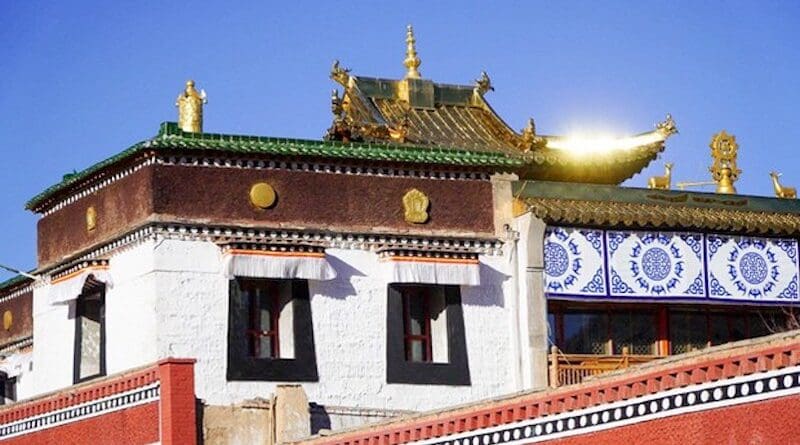Historic Tibetan Buddhist Monastery Being Moved To Make Way For Dam – Analysis
By RFA
By Pelbar, Tenzin Pema and Gai Tho
Authorities have begun relocating a 19th-century Tibetan Buddhist monastery in China that is expected to be submerged under water after the completion of the world’s tallest 3D-printed hydropower dam, two sources from the region told Radio Free Asia.
The expansion of the Yangqu hydropower station on the Yellow River – known as the Machu River among the Tibetans – in Qinghai province was started in 2022 and will be completed later this year.
For the past two years, monks from Atsok Gon Dechen Choekhorling Monastery in Dragkar county, or Xinghai in Chinese, have petitioned authorities to rescind relocation orders issued by China’s National Development and Reform Commission, or NDRC, a Tibetan source said, insisting on not being identified to protect his safety.
But in April 2023 the government’s Department of National Heritage declared that the artifacts and murals inside the monastery were of “no significant value or importance” and that its relocation would proceed, he said.
Chinese authorities have announced to local residents that they will fund the costs of dismantling and reconstructing the monastery, and performing ceremonies and rituals at the relocated area, the sources said.
However, many of the murals and surrounding stupas cannot be physically moved and so will be destroyed.
Tibetans also believe that the place is sacred: That it has been made holier over 135 years of prayers and practice by generations in the same venue.
Disregard for cultural heritage
The dam’s construction, Tibetans say, is yet another example of Beijing’s disregard for their culture, religion and environment.
Videos obtained by RFA showed a relocation ceremony being held earlier this month outside Atsok Monastery while authorities addressed local residents from a stage flanked by trucks and cranes on both sides.
“The resettlement work could begin with the government’s approval and the support of the local population,” a local Chinese official can be heard saying in one video.
Other footage obtained by RFA show scores of Tibetan residents praying and prostrating themselves on the road and in the fields before stupas near Atsok Monastery in what sources said was their way of “bidding farewell to this ancient monastery that has been their place of devotion for generations of Tibetans.”
The monastery, founded in 1889 and named after its founder Atsok Choktrul Konchog Choedar, is home to more than 160 monks. In 2021, the government issued an order forbidding monks under the age of 18 from enrolling or studying and living in the monastery.
And while authorities have announced that the monks and residents of nearby villages will be relocated to Khokar Naglo, near Palkha township, no alternative housing has been built for the monks, the sources said.
Seizing land
Tibetans often accuse Chinese companies and officials of improperly seizing land and disrupting the lives of local people, sometimes resulting in standoffs that are violently suppressed.
In February, police arrested more than 1,000 Tibetans, including monks, who had been protesting the construction of a dam in Dege county in Sichuan’s Kardze Autonomous Tibetan Prefecture, that would submerge at least six monasteries and force several villages to be moved.
The NDRC said the Yangqu dam will force the relocation of 15,555 people – nearly all ethnic Tibetans – living in 24 towns and villages in three counties — Dragkar, Kawasumdo and Mangra. Dragkar county sits in Tsolho, or Hainan in Chinese, Tibetan Autonomous Prefecture in the historic Amdo region of Tibet.
They warned the head of the monastery and residents that they “will be punished for any disturbance caused,” the sources said.
The Yangqu hydroelectric plant — expected to generate about 5 billion kilowatts of power annually to Henan province — is an expansion of the Yangqu Dam that was first built in 2010 and began operating in 2016 as a 1,200-megawatt hydropower station.
The expanded hydropower dam is expected to be the world’s tallest structure built with 3D printing, as detailed by scientists in the Journal of Tsinghua University.
The first section of the dam, said to be over 150 meters (about 500 feet) tall, is scheduled to become operational this year, and the entire project operational the following year.


Eco-Colonialism by China have no place for religion and heritage especially of the Tibetans and Muslims. China is known for double speak and counter actions. For the Atsok Monastery the Department of National Heritage declared that the artifacts and murals inside the monastery were of “No significant value or importance-its relocation would proceed.” Costs of dismantling and reconstructing the monastery and performing ceremonies and rituals at the relocated area will be funded. Murals and surrounding stupas cannot be physically moved and so will be destroyed or to say submerged in the dam. Nothing matters more than economic growth for the Govt; culture or religion. The expanded hydropower dam is expected to be the world’s tallest at about 500 feet and built with 3D printing. Tibetan residents cannot do anything more than praying and prostrating to bid farewell to their ancient Atsok Monastery.